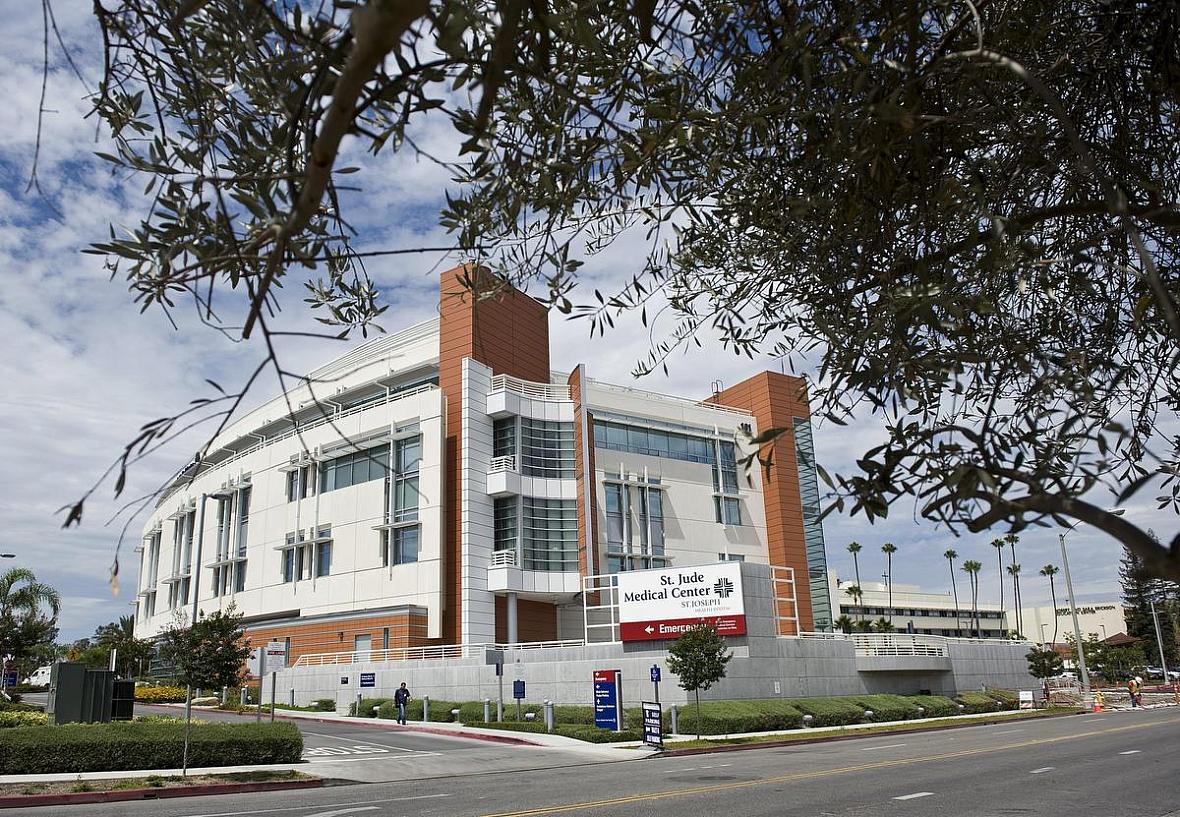Top hospitals in Calif.'s Orange County battle infections among patients
Jenna Chandler is a health reporter at the Orange County Register, where she has also covered breaking news, education and transportation. This story was produced as a project for The California Health Journalism Fellowship, a program of the USC Annenberg School for Communication and Journalism.
Other stories in the series include:
How hospitals fail to prevent infections
Federal inspection report finds Orange County hospital in crisis

At St. Jude Medical Center in Fullerton, holes in the walls of four operating rooms, which can lead to the release of molds, were cited in documents.
Every year, millions of Americans check into hospitals to get healthier only to end up sicker because of infections.
Patients come into constant contact with surfaces – from bed linens to surgical tools to caregivers’ hands – that, in hospitals, are particularly prone to contamination by harmful bacteria, viruses and fungi.
For people already sick enough to be hospitalized, that exposure can be lethal. Infections from such pathogens kill or contribute to the deaths of an estimated 75,000 hospital patients a year, or roughly as many Americans who annually die from diabetes.
Hospitals can prevent most infections – but inspection records show many fail to follow protocols that can keep patients safe.
“Hospitals are large, very complex places; there’s so many different things that could go wrong and things are going wrong all the time,” said Richard Martinello, medical director of epidemiology at Yale-New Haven Hospital and an associate professor of infectious diseases.

The Register reviewed federal inspection reports for five of the county’s six biggest hospitals – St. Jude Medical Center in Fullerton, St. Joseph in Orange, Hoag Memorial in Newport Beach, Mission Hospital in Mission Viejo and UC Irvine Medical Center in Orange. Fountain Valley Regional is the county’s fifth biggest hospital, but it hasn’t been surveyed since 1993 by the Centers for Medicare and Medicaid Services, which only investigate when there is a complaint.
The hospitals tracked generally met the average infection rates for hospitals of their size nationally – hospital administrators said their infection rates show that their hospitals are safe.
Still, during several inspections over the past five years, federal regulators cited the five local hospitals tracked by the Register nearly 100 times for infection control violations.
The most common problems were incorrectly sterilized surgical tools and machines, and dirty operating rooms and equipment, records show.
But some of the less common infection hazards were as diverse as a dirty diaper on the floor of a neonatal intensive care unit and an operating room sink that didn’t offer a view of a clock to time surgical scrubs, to a nurse failing to wear a mask or gloves while treating a patient in an isolation room.
Public health experts and some officials from some of the hospitals said the violations underscore a need for more attention to infection control.
“The findings are not surprising, are not right, and all too often are found in health care facilities throughout the U.S.,” Martinello said, describing the violations as red flags that often signal “significant problems” reflecting a “permissive” culture and lack of resources.
Among the other problems cited in the reports:
• Holes in the walls of four operating rooms at St. Jude Medical Center in Fullerton, which can lead to the release of infection-causing molds, dust or building materials into what is supposed to be a sterile environment.
• Paper trash, a suture and a pair of gloves left on the floor of a cardiovascular operating room at St. Joseph Hospital in Orange. An anesthesia cart was rusty and contained packages of syringes coated in brown residue. There was no documentation that the room was cleaned weekly, as required.
• Four doctors at Hoag Memorial Presbyterian in Newport Beach carried unwrapped, medication-filled syringes in their coat pockets. Needles and syringes are only supposed to be unwrapped immediately before use to keep them sterile.
• Tears in chairs and stools, rust on the bases of procedure tables, chipped paint on door frames and spots of what looked like blood on an X-ray viewing screen in operating rooms at Mission Hospital Regional Medical Center in Mission Viejo.
• “Heavy” dust on a procedure table, the pad on which had multiple black and brown spots, at UC Irvine Regional Medical Center in Orange. A radiologic technician told inspectors, according to the report, he had never removed the linen on the table.
Administrators at all of the hospitals cited acknowledged the problems and said they were committed to fixing them.
“As long as we have one hospital-acquired infection – I’m not OK with that,” said Dr. Jack Cox, the chief medical officer for St. Joseph Hoag Health, which includes Mission Hospital, St. Jude, St. Joseph and Hoag.
“Our goal is none,” Cox said, adding: “In reality, that is probably not a realistic goal or one that is achievable.”
The Joint Commission, a nonprofit that certifies most U.S. hospitals for Medicare funding, does routine inspections every three years, but its surveys are not public record. The commission is funded primarily by the hospitals through survey fees and annual dues.
The Centers for Medicare and Medicaid Services, the federal agency that reimburses health care providers for treating low-income patients, will conduct surveys but only in response to complaints.
Following its inspections, CMS threatened to revoke Medicare funding from St. Jude in 2012, from Hoag in 2013 and from Mission Hospital in 2014. Medicare is a major funding source for hospitals.
“Patients expect better, and they should,” said Dr. Douglas Merrill, chief medical officer at UC Irvine.
“I wish we were so good, (inspectors) never found anything,” he added. “But I’m glad they do find these things.”
Merrill noted UC Irvine changed a procedure – it began requiring anesthesiologists to wear alcohol-based gels on their waists – after a 2012 inspection found that one anesthesiologist had not changed his gloves as he went from task to task while treating a patient.
Transparency about infections is improving, but consumer advocates are pressing for more information.
As it stands, hospitals are required to report rates for some but not all types of infections, and those reports are made directly to the government. Public agencies and consumer groups are using that data, which can be up to 2 years old, to score, rank and compare hospitals so patients can shop for the facilities with the best outcomes.
But infection rates don’t always indicate if a hospital is doing a good or bad job preventing infections. They merely show if a hospital’s outcomes are similar to the averages of other hospitals across the state and country; inspectors do not consider those rates when they scour facilities, looking for operational and environmental flaws.
It’s not uncommon for a hospital to have average infection rates but still get in trouble for poor infection control practices.
For example, two years ago, when CMS threatened to revoke Medicare funding from Hoag, the hospital’s infection rates were mostly the same as state or national averages. It even had ratings for two types of infections that were better than the averages.
The public is often unaware about what’s going on inside hospitals to the level of detail included in inspection reports.
Inspection reports are generated to force hospitals to make improvements, and consumer advocates say the reports aren’t necessarily aimed at the public. The reports are released only under a Public Records Act request, after the hospital has had a chance to make fixes, often several months later.
“The public expects hospitals to follow those protocols, and when they’re cited for not doing it, the public should know about it,” said Lisa McGiffert, director of Consumer Union’s Safe Patient Project.
“It gives people more information about what’s happening, just like they might want to know if a particular model of car is failing repeatedly or if restaurants have caused food poisoning. We have these kinds of disclosures in other areas.”
Hospital administrators say it’s not always easy to follow protocol.
Clinicians and caregivers develop bad habits; they’re also juggling efforts to prevent other common errors, including falls, bed sores and wrong-site surgeries.
“The question is, where do you put your resources? Do you have someone follow a physician around 24/7 and see if they’re cleaning their hands each time? Is that a good use of resources?” Yale’s Martinello said.
Hospitals are improving.
Last year, the U.S. Department of Health and Human Services reported 1.3 million fewer hospital-acquired infections from 2010 to 2013, a 17 percent drop.
Experts credit some of the improvement to the Affordable Care Act. The law set new financial incentives and penalties from Medicare that have prompted hospitals to revamp their infection control policies.
St. Joseph Health’s Cox and Martinello said some of the deficiencies cited in infection reports – like a soiled diaper on the floor of the neonatal intensive care unit or an anesthesiologist not covering his hair all the way – were not likely to put a patient in harm’s way.
But there are still infections – and sometimes that leads to patients being re-hospitalized with sores or high fevers. They can also be deadly.
“It isn’t a small thing to a patient that you didn’t wash your hands and they got an infection – patients pay the ultimate price,” said Leah Binder, CEO of Leapfrog Group, which gives letter grades to hospitals for preventable errors, accidents, injuries and infections.
Binder said hospitals need to do everything possible to curb the spread of infection.
“It’s the little things that count. It’s the washing the linens. Dusting. It’s the humble things that keep patients safe.”
[This story was originally published by The Orange County Register.]
